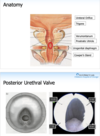SM_198b: Congenital Pediatric GU Anomalies Flashcards
(64 cards)
Congenital anomalies of the kidney and collecting system are ____, ____, and ____
Congenital anomalies of the kidney and collecting system are multicystic dysplastic kidney, antenatal hydronephrosis / urinary tract dilation, and ureteropelvic junction obstruction
Congenital anomalies of the ureters are ____ and ____
Congenital anomalies of the ureters are vesicoureteral reflux and ureteral duplication
Congenital anomalies of the urethra are ____ and ____
Congenital anomalies of the urethra are posterior urethral valves and hypospadias
Congenital anomalies of the scrotum are ____ and ____
Congenital anomalies of the scrotum are undescended testes and pediatric hydroceles / hernia
Three stags of renal development are ____, ____, and ____
Three stags of renal development are
- Pronephros
- Mesonephros (Wolffian ducts)
- Metanephros

Proper development of the kidney and ureters requires interaction of the ____ with the ____
Proper development of the kidney and ureters requires interaction of the ureteric bud (mesonephric duct) with the metanephric blastema
- Failure leads to congenital anomalies of the GU tract

____ and ____ must interact for the kidney and ureters to properly develop
Ureteric bud (mesonephric duct) and metanephric blastema must interact for the kidney and ureters to properly develop

____ occurs if the ureteric bud does not connect / contact the metanephric blastema
Multicystic dysplastic kidney occurs if the ureteric bud does not connect / contact the metanephric blastema
____ is the most common cystic renal disease in children, is more common on the left and in boys, and is diagnosed with ultrasound
Multicystic dysplastic kidney is the most common cystic renal disease in children, is more common on the left and in boys, and is diagnosed with ultrasound

Ultrasound finding of multicystic dysplastic kidney is ____
Ultrasound finding of multicystic dysplastic kidney is lack of reniform shape

Describe pathology of multicystic dysplastic kidney
Multicystic dysplastic kidney pathology
- Multiple non-communicating cysts
- No identifiable normal renal parenchyma
- Ureteral with or without pelvic atresia
- Immature glomeruli are often present
Multicystic dysplastic kidney pathophysiology involves ____ and ____
Multicystic dysplastic kidney pathophysiology involves malunion of the ureteric bud with the metanephric blastema and early obstruction of the ureter
Multicystic dysplastic kidney workup involves ____ and identifying contralateral pathology using ____ and ____
Multicystic dysplastic kidney workup involves ultrasound and identifying contralateral pathology using voiding cystourethrogram and radionucleotide renal scan
One-third of patients with mutlicystic dysplastic kidney have ___
One-third of patients with mutlicystic dysplastic kidney have contralateral vesicoureteral reflux
(voiding cystourethrogram)
Multicystic dysplastic kidney natural history is typically ____
Multicystic dysplastic kidney natural history is typically involution
(nephrectomy is seldom necessary)
____ results if there is an abnormality with ureteral development after the ureteric bud joins the metanephric blastema
Hydronephrosis / urinary tract dilation results if there is an abnormality with ureteral development after the ureteric bud joins the metanephric blastema
Describe embyrological ureteral development
Embyrological ureteral development
- Days 28-35: ureter patent due to urine from mesonephros
- Days 37-40: ureter loses its lumen
- Day 40: ureter regains its lumen (midpoint outwards to distal and proximal ureter, last segments to recanalize are ureteropelvic and ureterovesical junctions), ureter invests into the UG sinus (bladder) separated by Chawalla’s membrane (rupture leads to open communication between the ureter and bladder)
- Week 9: fetal kidney produces urine, ureteral lumenal patency
Last segments of ureter to recanalize at day 40 are ____ and ____
Last segments of ureter to recanalize at day 40 are ureteropelvic and ureterovesical junctions

Hydronephrosis is ____
Hydronephrosis is dilation of the urinary tract as a consequence of some degree of obstruction
(use the term urinary tract dilation)
Antenatal urinary tract dilation is most often diagnosed ____ and ____ is the prenatal ultrasound standard of care
Antenatal urinary tract dilation is most often diagnosed antenatally and 20 week is the prenatal ultrasound standard of care
Describe urinary tract dilation grading
Urinary tract dilation grading
- Grade 0: no hydro
- Grade 1: slight pelvic dilatation, no calyceal dilatation
- Grade 2: moderate pelvic dilatation, slight calyceal dilatation (major calyces)
- Grade 3: large pelvis, dilated calcyes (minor calyces), normal parenchyma
- Grade 4: large pelvis, dilated calyces, thinned parenchyma

Antental hydronephrosis most commonly presents with ____, ____, and ____
Antental hydronephrosis most commonly presents with isolated antenatal hydronephrosis, ureteropelvic junction obstruction, and vesicoureteral reflux

Describe ureteropelvic junction obstruction
Ureteropelvic junction obstruction
- Males > females
- Left > right
- May lead to renal deterioration
- 10-40% bilateral
Describe etiologies of ureteropelvic junction obstruction
Ureteropelvic junction obstruction etiologies
- Intrinsic: aperistaltic segment, intrinsic narrowing, ureteral polyps
- Extrinsic: high insertion, kinking secondary to periureteral fibrosis, and crossing vessel























